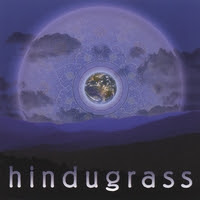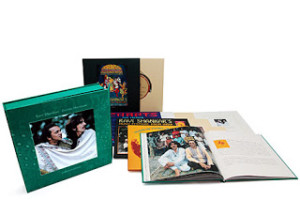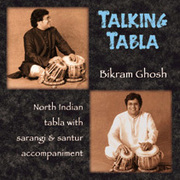Hindugrass
by John Heitzenrater, Carolyn Balfe, Yunior Terr, Evan Fraser, and Austin Wrinkle
[Music CD]

view/request
What could you find in common between the classical and folk music of Northern India, and old time and bluegrass music of the Southeastern United States? Quite a lot actually, and Hindugrass does an excellent job exploring and exploiting those similarities. Headed by John Heitzenrater on sarod, Hindugrass is alternatively haunting and driving, lyrical and percussive, familiar and strange. In addition to sarod we hear, fiddle (played in American style), bass, tabla, kanjira, bones, and other percussive instruments. The melodies comfortably shifts back and forth between a more eastern and a more western sound, but the rhythms show a primarily Indian influence, with the melodic and percussive instruments alike taking part in the polyrhythm, tihai, and other rhythmic devices that are responsible for much of the excitement of Indian music. This is an exciting recording for lovers of Appalachian and Indian music alike. You can get a preview of their music at http://www.hindugrass.net/, or borrow the CD from the library to hear the whole thing!
Reviewed by Ben
Tagged: Folk music, Indian music, World music
Collaborations
by Ravi Shankar & George Harrison
[Music CD]

view/request
George Harrison was first wowed by the sitar, a traditional Indian stringed instrument, on the set of the Beatles film Help!. The young pop star was intrigued and transfixed by the music he heard. He later went out and bought his own sitar at a shop in London and found his way round the neck enough to dub a part onto “Norwegian Wood” on the Rubber Soul album. Harrison then wanted to go beyond his rudimentary plucking on the instrument and properly learn. Well, why not get lessons from the master Ravi Shankar?
The two studied together in Los Angeles, California and later in India. Though the Beatle did not pursue a career with the sitar after discovering the amount of years, intense training and discipline it takes to play classical Indian music, he and Shankar became life long friends. This boxed set Collaborations celebrates the two musicians’ friendship, spiritual connection and recorded musical partnerships. Harrison was involved as a producer (and sometimes a musician) on three of Shankar’s albums ranging from 1974-1997 and they all appear here along with a live concert dvd and a beautiful hardcover book.
Reviewed by Jason
Tagged: Indian music, Pop music
Talking Tabla
by Bikram Ghosh
[Music CD]

view/request
Talking Tabla is an exciting recording showing off the work of a masterful tabla player. The tabla is a popular Indian percussion instrument, and is ubiquitous in the classical music of Northern India. The tabla consists of two hand drums of contrasting designs: on the left is a kettle drum with a deep sound and variable pitch; on the right is smaller conical drum with a high, fixed pitch. The drums are struck with the fingers and palms of the hands to create the sounds known as bols, these are the syllables of North Indian drumming and can be spoken as well as played; well performed, they sound very much like language, hence the title of this album, Talking Tabla.
On Talking Tabla Bikram Ghosh plays a variety of compositions, fixed and improvised, in a variety of styles, including a piece in the less familiar Carnatic style of South India. Although Bikram Ghosh’s tabla is the focus of these recordings we are not deprived of melody—Ramesh Mishra does a beautiful job playing the sarangi (a kind of elaborate fiddle) on several tracks and on the third track Ghosh accompanies Tarun Bhattacharya’s santoor (hammered dulcimer). In addition, Ghosh’s beautiful baya (left hand drum) application creates a kind of melody of its own. (To fully appreciate this a pair of good speakers or headphones are recommended—don’t listen to this one through your laptop speakers!) Even those who are bored by the idea of an album devoted to the drums should consider listening to Talking Tabla.
Reviewed by Ben
Tagged: Drums, Folk music, Indian music



